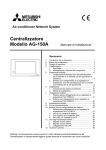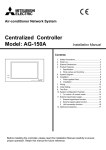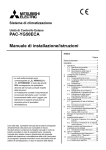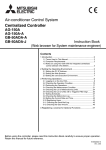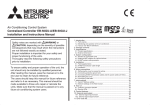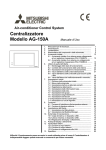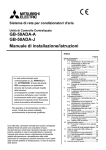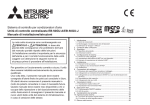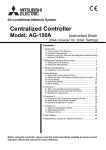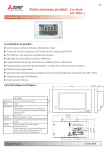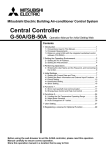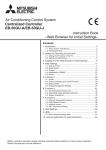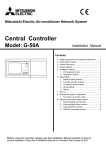Download Mitsubishi AG-150A-A Installation manual
Transcript
Air-conditioner Control System Centralized Controller AG-150A AG-150A-A Installation Manual Contents 1. 2. 3. 4. 5. 6. 7. 8. 9. 10. 11. 12. 13. Safety Precautions ..................................................1 Parts List .................................................................2 External Dimensions ...............................................3 Product Features.....................................................4 1. Specification......................................................4 2. Parts names and functions ...............................4 System Diagram......................................................6 1. Standard configuration (using the AG-150A to control a system with 50 or fewer units of equipments) ..................................................6 2. System with connection to an Expansion controller (system with 50 or more units) ......8 Installation .............................................................10 1. Field-supplied Parts ........................................10 2. Installation.......................................................10 Wiring ....................................................................21 1. System without connection to a PAC-YG50ECA Expansion controller .....................................21 2. System with connection to a PAC-YG50ECA Expansion controller ...................................22 Initial Setting..........................................................23 Test Run................................................................24 System Configuration Example.............................25 1. System with connection to a PAC-YG50ECA Expansion controller ...................................25 2. Using multiple system controllers ...................25 3. To control a Mr. Slim.......................................25 4. To control a K control model ...........................25 External input/output usage ..................................26 1. External signal input function ..........................26 2. External signal output function........................27 LAN connection function .......................................28 Optional Accessories ............................................29 Before installing the controller, please read this Installation Manual carefully to ensure proper operation. Retain this manual for future reference. This manual describes how to install the centralized controller and wiring. Before installing the controller, read the 1 Safety Precautions section carefully to ensure proper installation. 1 Safety Precautions Safety symbols used in this manual The following symbols are used in this manual to indicate the type and severity of potential consequences that may result when given instructions are not followed exactly as stated. WARNING Indicates a risk of death or serious injury. CAUTION Indicates a risk of injury or damage to the controller. Retain the Installation Manual and the Instruction Book for future reference. Make sure both the Installation Manual and the Instruction Book are passed to any future air condition system users. WARNING The controller must be professionalling installed. Improper installation by an unqualified person may result in electric shock or fire. Securely install the controller according to the installation manual. Improper installation may result in electric shock or fire. Make sure the controller is securely mounted so that it will not fall. Electric work must be perform by authorized personnel according to the local regulations and the instructions detailed in the installation manual. Inadequate circuit capacity or improper installation may result in electric shock or fire. Only use specified cables. Securely connect each cable so that the weight of the cable is not applied to the connectors. Loose or improper connections may result in heat generation or fire. Ask your dealer or an authorized technician to move the controller. Improper installation may result in electric shock or fire or damage to the controller. Do not attempt to modify or repair the controller. Modification or improper repair may result in electric shock or fire. Consult your dealer when repairs are necessary. CAUTION Do not install the controller where there is a risk of flammable gas. If the leaked gas accumulates around the controller, it may ignite and cause an explosion. Do not install this controller in a place that has the potential for steam or dew formation. Steam or dew formation may cause an electric shock or a unit malfunction. Do not use the controller in an environment high in oil, steam, or sulfuric gas. These substances may have adverse effects on the performance of the controller or damage its parts. Do not install this controller where an acid or alkaline solution or special chemical spray is used frequently to avoid electric shock or malfunction. When installing the controller in a hospital or communication facility, take appropriate measures to reduce electrical noise interference. Inverter equipment, generators, high-frequency medical equipment, or radio communication equipment may interfere with the normal operation of the controller; or the electrical noise from the controller may interfere with the medical practice or cause image distortion and static. To prevent over-heating and fire, wire so that the weight of the cable will not strain the connectors. Seal the wire lead-in port with putty to prevent the entry of dew, water, and insects to avoid electric shock or malfunction of the controller. Do not wet the controller. Water may damage the controller and cause an electric shock. Do not install this controller where the ambient temperature exceeds 40°C (104°F) or drops below 0°C (32°F). To prevent the controller from being damaged and malfunctioning, install it out of direct sunlight. To reduce the risk of electric shock, install and wire the unit with the power to the PAC-SC51KUA power supply unit turned off. Consult an authorized agency for the proper disposal of the unit. The backlight (fluorescent lamp) of the liquid crystal display module contains a minute amount of mercury, which is harmful to the environment. Use specified wires with the proper current carrying capacity to prevent current leakage, over-heating, or fire. Do not touch the PCB (Printed Circuit Board) with your hand or a tool. Keep the PCB dust-free to prevent fire or malfunction. To avoid the risk of electric shock or damage to the controller, do not touch the touch panel or USB storage device connector with wet hands. To avoid the risk of electric shock or damage to the controller, do not press the touch panel with sharp objects. To avoid causing damage or fire, do not apply an AC voltage or a voltage higher than 32VDC to the M-NET or the Power (24VDC) terminal blocks on the controller. Use a security device such as a VPN router when connecting the AG-150A, AG-150A-A to the Internet to prevent unauthorized access. -1- 2 Parts List * The Installation Manual and the parts listed below are included with the unit. No. 1 Description AG-150A or AG-150A-A Centralized controller Usage Qty. 1 2 A type Installation plate Use to attach the AG-150A or AG150A-A using the B type installation plate or the Electric box (PACYG83UTB; sold separately) on the wall or in the control board. 1 3 B type Installation plate Use to install the AG-150A or AG-150AA on the wall using the A type installation plate. 1 4 Wood screw (M4.1×25)*1 For mounting the controller directly on the wall 4 5 M4 flathead screw (M4×40)*1, 2 4 6 M4 roundhead screw (M4×12)*1 For attaching the A type installation plate to either the B type installation plate or electric box (PAC-YG83UTB; sold separately) For attaching the AG-150A or AG150A-A to the A type installation plate 7 8 9 Installation Manual Instruction Book Instruction Book (Web browser for System maintenance engineer) Instruction Book (Web browser for Initial Settings) License sheet 0 a 4 1 1 1 1 1 *1 ISO metric screw thread *2 If the enclosed screw for attaching the installation plate cannot be used because the wall is too thick, obtain a longer M4 flathead screw that matches the wall thickness. * Besides the above parts, purchase a power supply unit (PAC-SC51KUA) that supplies power to the centralized controller (24VDC) and the M-NET transmission line. AG-150A and AG-150A-A operate by receiving 24VDC power from PAC-SC51KUA. A PAC-YG50ECA Expansion controller (sold separately) is required to control 50 or more units of equipments (e.g., indoor units and LOSSNAY units). Up to three Expansion controllers can be connected to a system, each of which can control up to 50 units of equipments. To control 50 or more units of equipments, use AG-150A, AG-150A-A software version 2.10 or later. Hereinafter, Centralized controller AG-150A, AG-150A-A, unless otherwise specified, will be called "AG-150A". -2- 3 External Dimensions 25.6 (1-1/16) Unit: mm (in) 44.7 (1- 13/16) 185 (7- 5/16) 300 (11-13/16) 272 (10-3/4) Back View 272 (10-3/4) 146 (5-3/4) A type installation plate B type installation plate Unit: mm (in) 278 (10-15/16) 250 (9-7/8) 250 (9-7/8) 7/8) 200 (7-7/8) 152 (6) 167 (6-5/8) 175.8 (6-15/16) 147 (5-13/16) 163.4 (6-7/16) 200 (7- 4 6 (3/16) (1/4) ø6 ø4 (1/4) (3/16) -3- 167 (6-5/8) 273 (10-3/4) 185 (7-5/16) 300 (11-13/16) (11-1/2) 163.4 (6-7/16) 290.8 167 (6-5/8) 250 (9-7/8) 4 Product Features AG-150A is a centralized controller that features advanced functions such as the Web function. Air conditioning units connected to this controller can be operated or monitored directly from this controller or over the Web by purchasing a license, using a browser software on the computer. Up to 50 indoor units and general equipment can be monitored and operated from an AG-150A unit. By connecting three PAC-YG50ECA Expansion controllers (sold separately), a maximum of 150 units of equipments can be controlled. 1. Specification Item Power supply Temperature Humidity Weight Dimensions (W × H × D) Specifications M-NET Terminal 17VDC~32VDC * Power supply: PAC-SC51KUA Controller drive 24VDC Operating 0~40°C [32~104°F] For indoor installation only Non operating -20~60°C [-4~140°F] * To be used in an business office or similar environment 30~90%RH (No condensation) 2.1kg [4.6 lbs] 300 × 185 × 70.3 [25.6] mm 11-13/16 × 7-5/16 × 2-13/16 [1-1/16] in * [ ]: indicate the thickness from the wall. 2. Parts names and functions Front View POWER LED Lit: Power ON Unlit: Power OFF ON/OFF LED Lit: One or more units are in operation. Unlit: All units are stopped. Blink: One or more errors have occurred. Display/Touch panel -4- Left view USB storage device Connects to a USB storage device to copy and read data from the AG-150A Back View CN3 Unused CN4 Unused LAN Connects to other units of equipments over the LAN via a switching HUB. CN2 Connects to the power cable when CN5 the mounting attachment A type (PAC-YG85KTB; sold separately) Connects to PAC-YG10HA external input/output adapter is used to attach the controller. V+, V-, FG Connects to power supply unit (PAC-SC51KUA) that supplies 24 VDC power. (V+: +24VDC terminal, V-: 0V terminal, FG: Functional earthing terminal; ground) CN1 Connects to the M-NET cable when the mounting attachment A type (PAC-YG85KTB; sold separately) is used to attach the controller. Do not use this terminal when a PAC-YG50ECA Expansion controller is used. A,B,S Connects to the M-NET transmission cable from the power supply unit (PAC-SC51KUA). (A, B: M-NET transmission cable terminal: non-polarized, S: Shield terminal) Do not use this terminal when a PAC-YG50ECA Expansion controller is used. NOTE * M-NET terminal (A, B, S) and CN1 cannot be used simultaneously. * Power supply terminal block (V+, V-, FG) and CN2 cannot be used simultaneously. -5- 5 System Diagram 1. Standard configuration (using the AG-150A to control a system with 50 or fewer units of equipments) POWER (24VDC) LAN Centralized controller Model:AG-150A Indoor unit Power supply unit (optional) Model: PAC-SC51KUA Local remote controller M-NET transmission line K transmission line M-NET outdoor unit TB7 M-NET MA remote controller line The numbers in the indicate the address No. Group 1 TB3 Group 2 003 MA M-NET outdoor unit R2 004 MA BC controller Group 3 TB7 LOSSNAY TB3 ME Mr. Slim Outdoor unit Mr. Slim Outdoor unit M-NET adapter Group 5 Group 4 MA MA K control outdoor unit Group 13 TB7 K transmission converter 213 Group 15 TB3 K 13 K NOTE * This diagram does not show the AC power supply wiring. Only the configuration for the transmission line is shown. 15 Model:PAC-SC25KAA * Address setting for each M-NET device (Addresses cannot be duplicated). Address setting method Set the indoor unit you want to make the main unit in the same group to the minimum Indoor unit address, then sequentially set the indoor unit addresses in the same group. Outdoor unit Minimum indoor unit address in same refrigerant system + No.50 unit. Outdoor unit address in same refrigerant system + No.1 unit. BC controller/OS controller However, for Sub-BC controller, the minimum indoor unit address that connects the local refrigerant piping should be + 50. K control side remote controller Same address as indoor unit main unit. Same address as indoor unit main unit. An M-NET adapter (sold separately) is required. Mr. Slim Outdoor unit M-NET remote controller Set to the minimum indoor unit main address in the same group + 100. Sub system controller Assign an address that equals the lowest group number plus 200. Assign an arbitrary but unused address to the PAC-YG66DCA DIDO controller after DIDO controller assigning an address to all units to be assigned an address between 1 and 50. (PAC-YG66DCA) The number of controllable units depends on the number of channels used. Assign an arbitrary but unused address to the PI controller after assigning an address Pl controller (PAC-YG60MCA) to all units to be assigned an address between 1 and 50. Assign an arbitrary but unused address to the AI controller after assigning an address Al controller (PAC-YG63MCA) to all units to be assigned an address between 1 and 50. MA remote controller Address setting is unnecessary. OA processing unit/LOSSNAY After setting all the indoor units, set an arbitrary but unused address. K transmission converter Minimum address of K control indoor unit + 200. Set the Air To Water you want to make the main unit in the same group to the minimum Air To Water address, then sequentially set the Air To Water addresses in the same group. -6- Address 1~50 51~100 52~100 1~50 1~50 101~200 201~250 1~50 1~50 1~50 1~50 201~250 1~50 NOTES * Apply following precautions when using the K transmission converter (model PAC-SC25KAA; discontinued) and controlling the M-NET model and K control model with the same controller. Refer to the K transmission converter (PAC-SC25KAA) installation manual for details. 1 Centralized controller address Always set the controller address to “000”. 2 Centralized controller function selects Set the “K Converter Address” by using the “M-NET Settings” on the Initial settings screen. 3 Indoor unit address Set all M-NET model indoor units from the No.1 unit, then set the K control model addresses. Indoor unit No.1 unit ~M-NET indoor unit max. address> K control indoor unit minimum address ~50 4 K control model group No. The minimum indoor address No. of that group becomes the group No. (Same for K control side local remote controller.) 5 The remote controller address does not need to be included in the K-control unit group settings. NOTE * Some types of units cannot be controlled from the AG-150A controller. 1-1. M-NET wiring configuration (1) Types and maximum allowable length of M-NET transmission cables Cable type Facility type All facility types Type Shielded cable CVVS·CPEVS No. of cores 2-core cable Cable size Minimum 1.25 mm2 Maximum transmission line distance between the outdoor unit and the farthest indoor unit 200 m Distance of the transmission line for the central control system and indoor-outdoor transmission line to the farthest indoor unit (Maximum line distance via outdoor unit) 500 m * The maximum line distance from the power supply unit on the transmission line for the central control system to each outdoor unit or to the system controller is 200 m. The wiring diagram below shows a sample M-NET transmission wiring for a CITY MULTI system. The maximum total line distance (centralized control and indoor-outdoor transmission lines) for each M-NET system is expressed in the formula below. Observe the maximum length to ensure proper signal transmission to and from the connected equipments over the M-NET transmission line. If the maximum line length is exceeded, the M-NET signals will be attenuated, resulting in communication error and control failure. a+b+d+e(f) ≤ 500m a+b+c+g ≤ 500m e(f)+d+c+g ≤ 500m The local remote controller cable length should be 10 m or shorter. The part that exceeds the 10 m limit should be included in the maximum total line length of 500 m. Centralized control transmission line b Centralized controller (AG-150A) Power supply unit for transmission line Outdoor unit Indoor-outdoor transmission line d e Indoor unit a Indoor unit c f Indoor unit 10m M-NET remote controller g Outdoor unit Indoor unit Indoor unit (A) Centralized control transmission line The power supply distance for the centralized controller transmission line is expressed in the formula below. This is the maximum length of the centralized control transmission line to which proper amount of power reaches. If the maximum line length is exceeded, those equipments at the end of the transmission line may not receive enough power, resulting in communication error and control failure. a+b ≤ 200m a+b+c ≤ 200m (B) Indoor-outdoor transmission line The power supply distance for the indoor-outdoor transmission line is expressed in the formula below. This is the maximum length of the indoor-outdoor transmission line to which proper amount of power reaches. If the maximum line length is exceeded, those equipments at the end of the transmission line may not receive enough power, resulting in communication error and control failure. d+e(f) ≤ 200m g ≤ 200m The length of the local remote controller cable that exceeds the 10 m limit should be included in the maximum total line length of 500 m and in the power supply distance of 200 m. -7- 2. System with connection to an Expansion controller (system with 51 or more units) Power supply (DC24V) LAN Centralized controller Model name: AG-150A *1 192.168.1.1 Power supply unit (sold separately) Model name: PAC-SC51KUA *2 M-NET Outdoor unit Switching HUB LAN Expansion controller Model name: PAC-YG50ECA 192.168.1.211 M-NET 051 TB7 TB3 Indoor unit *1: M-NET terminals will not be used. *2: Terminal block TB2 will not be used. Local remote controller LAN Figures in Figures in Group 1-1 001 M-NET transmission line indicate IP address. indicate M-NET address. Group 1-2 002 003 004 005 000 ME M-NET R2 Outdoor unit ME 101 103 BC controller LOSSNAY unit Group 1-3 056 TB7 TB3 LAN 057 006 ME 007 008 Expansion controller Model name: PAC-YG50ECA 192.168.1.212 M-NET 051 TB7 TB3 001 ME 000 002 LOSSNAY unit Group 2-2 003 ME 101 004 Expansion controller Model name: PAC-YG50ECA 192.168.1.213 000 M-NET 051 TB7 TB3 001 ME 002 101 LOSSNAY unit Group 3-2 003 ME 005 • This diagram only shows transmission line configurations. Power wires are omitted. 103 M-NET Outdoor unit Group 3-1 010 106 M-NET Outdoor unit Group 2-1 009 004 005 103 • Refer to the PAC-YG50ECA Expansion controller Installation/Instructions Manual for how to set the IP address. • The same M-NET address cannot be used twice in the same M-NET system that connects to the same PAC-YG50ECA Expansion controller. See section 1 “Standard configuration” for how to set the addresses for the equipments that are connected to the Expansion controller within an M-NET system. NOTES * The DB No. of PAC-YG50ECA is found on the package box and the controller itself in the [DB No. : **] format. Only the Expansion controllers with the same DB No. as the AG-150A can be connected to the AG-150A. Be sure to check the DB No. before connecting the Expansion controller to the system. If the DB numbers of the AG-150A and PAC-YG50ECA do not match, the software needs to be updated. Consult your dealer. Label contents DB No. appears here. * Provide “one-point grounding” for the M-NET transmission line (centralized control system) by grounding the shield of the an Expansion controller. (Class-D grounding) Ground the indoor-outdoor transmission line in each outdoor unit refrigerant system. * Set the centralized control switch (SW2-1) on the outdoor units on the M-NET line to ON. (Refer to the outdoor unit Installation Manual for the details of the dipswitch settings.) -8- NOTES * Up to three PAC-YG50ECA controllers can be connected to each AG-150A unit. * Main system controllers (e.g., AG-150A) cannot be connected to an M-NET system that is controlled by an Expansion controller. * Main and sub system controllers (M-NET) AG-150A is for exclusive use as a main SC. AG-150A cannot be used as a sub SC. • Main system controller (Main SC) Main SC refers to a controller that controls all other system controllers including the units they control. If a given system has only one system controller, that controller becomes the main controller. Group settings and interlock settings can only be made from a main controller. • Sub system controller (Sub SC) Sub controller refers to a system controller that is controlled (including the units it controls) by a main system controller. AG-150A, PAC-YG50ECA etc. Range of units the main SC controls (M-NET) Range of units the sub SC controls Group NOTES AG-150A is for exclusive use as a main SC. AG-150A cannot be used as a sub SC or controlled from another main SC. Group Group The following types of configurations are not possible. • A sub controller can only control the groups that are under the control of its main controller. Main system controller Group Sub system controller Group Group • No groups can be placed under the control of more than one main system controller. Main system controller 1 Group Main system controller 2 Group Group • No sub system controllers can be placed under the control of more than one main system controller. Main system controller 1 Group Sub system controller Group -9- Main system controller 2 Group Group 6 Installation CAUTION * Install and wire the unit with the power to the power supply unit (PAC-SC51KUA) turned off. * Do not put the signal wire and power wire in the same conduit. * When routing the cable from the top of the controller, let the cable hang down below the connector before connecting it to the terminal block or connector as shown in the figure below to prevent water from running down the cable and causing electric shock or fire. Terminal block or connector Good example Bad example 1. Field-supplied Parts 1 Electric box: PAC-YG83UTB (sold separately) (When following installation method described in section “2. Installation” item 1.) 2 Mounting attachment B Type: PAC-YG81TB (sold separately) (Required only when following installation method described in section “2. Installation” item 3.) 3 Mounting attachment A Type: PAC-YG85KTB (sold separately) (Required only when following installation method described in section “2. Installation” item 4.) 4 Locknuts and bushing for the conduit tube. 5 M-NET transmission cable. (Refer to Page 12.) 6 DC power cable. (Refer to Page 12.) 2. Installation The controller can be installed by following one of the methods below: 1 By embedding the centralized controller in the wall. Method of using two plates included with AG-150A. AG-150A Wall 2 By embedding the centralized controller in the wall and mounting it to an electric box. An electric box (PAC-YG83UTB; sold separately) is required. Electric box (PAC-YG83UTB; sold separately) AG-150A Wall 3 By installing the centralized controller directly on the wall. Mounting attachment B type (PAC-YG81TB; sold separately) is required. Wall AG-150A PAC-YG81TB (sold separately) is required mount installations. - 10 - 4 By installing the centralized controller and a power supply unit (PAC-SC51KUA; sold separately) inside the mounting attachment on the wall. Mounting attachment A type (PAC-YG85KTB; sold separately) is required. Wall AG-150A PAC-YG85KTB (sold separately) is required in wall mount installation with both the controller and a power supply unit. Power supply unit (PAC-SC51KUA; sold separately) 5 Attach the AG-150A to the control board. Wall AG-150A Power supply unit (PAC-SC51KUA; sold separately) Control board 2-1. Embedding the centralized controller in the wall. 1 Ensure there is enough space to install the controller as shown in the figure at right. Unit: mm (in) 120 (4-3/4) 100 (3-15/16) 185 (7-5/16) 300 (11-13/16) 30 (1-3/16) 30 (1-3/16) AG-150A NOTES * When installing two or more controllers side-by-side and horizontally ensure that there is at least 130 mm (5-1/8 in) or more between the units. * When installing two or more controllers vertically, ensure that there is at least 150 mm (5-15/16 in) between units; otherwise, it will be hard to remove the cover. * The amount of space required on the left of the controller is the amount necessary to connect/disconnect the USB drive. (If the specified amount of space is not available, use a USB extension cable.) * The amount of space required under the controller is the amount necessary for the mounting/dismounting of the controller cover. 3 Insert the B type installation plate (supplied) through the hole in the wall and hold it. - 11 - Unit: mm (in) 278 (10-15/16) 163.4 (6-7/16) 200 (7-7/8) 152 (6) 2 Cut out an opening in the wall as shown in the shaded area in the figure at right. (W × H: 278 mm (11 in) × 152 mm (6 in)) Follow the dimensions in the figure exacting. If the opening is too large, it will be hard to properly install the unit. Make mounting plate (A type and B type) screw holes on the hole as shown in the right figure. (Use the supplied M4 screws to mount the plates.) B type installation plate (supplied) 4 Attach the A type installation plate (supplied) to the B type installation plate (supplied) with the M4 flathead screws (supplied), sandwiching the wall between the two plates. Prior to installation, check that the wall is strong enough to support the weight of the controller to prevent the controller from falling. Inside the wall M4 flathead screw (supplied) B type Installation plate (supplied) A type Installation plate (supplied) NOTE * If the screw provided for the installation plate, cannot be used because of the wall thickness, use an M4 flathead screw that matches the wall thickness. Wall 5 Remove the AG-150A surface cover. Insert a flat-tip screwdriver in the holes indicated and move the handle up to remove the cover. 6 Push the wire through the wall hole, and connect the M-NET transmission cable (centralized control cable that is connected to TB2 of the power supply unit (PAC-SC51KUA)) to M-NET transmission cable terminal A, B (both non polarity) and S. Connect the DC power cable from the power supply unit (PAC-SC51KUA) to the 24VDC power supply terminal block of the controller. There is V+ and V- polarity. Back of controller Shield M-NET DC power cable Function earthing transmission (ground) cable cable * When a PAC-YG50ECA Expansion controller is used, the M-NET terminals will not be used. * When using bridge wiring of the shield, use the S-terminal as shown below. M-NET transmission cable A DC power cable S B NOTE * When using an LAN and external signal I/O, refer to section 11 External input/output usage . M-NET transmission cable Type of the cable; Shielded cable which comply with the following specifications or equivalent. • CPEVS φ1.2mm to φ1.6mm • CVVS 1.25mm² to 2mm² (AWG16 to 14) *CPEVS; PE insulated PVC jacketed shielded communication cable *CVVS; PVC insulated PVC jacketed shielded control cable PE: Polyethylene PVC: Polyvinyl chloride DC power cable The DC power cable should comply with both local standards as well as the power requirement of the unit. Recommended type: 0.75mm² to 2mm² (AWG18 to 14), 3-conductor power cable Cable length: Within 50m (164 ft) CAUTION * Do not connect the AC power cable to the M-NET and POWER (24VDC) terminal blocks of the controller. It may cause a failure. - 12 - 7 Attach the controller to the A type installation plate with the M4 roundhead screws (supplied). A type Installation plate (supplied) M4 roundhead screw (supplied) 8 Replace the AG-150A surface cover. 2-2. Wall-Embedded installation with an Electric box (PAC-YG83UTB; sold separately) 1 Ensure there is enough space to install the controller as shown below. Wall space (see diagram below) and 60 mm (2-3/8 in) of clearance behind the wall are required to mount an Electric box. Electric box (PAC-YG83UTB; sold separately) Inner wall Unit: mm (in) 30 (1-3/16) 30 (1-3/16) AG-150A 120 (4-3/4) 100 (3-15/16) 185 (7-5/16) 300 (11-13/16) AG-150A 60 mm (2-3/8 in) minimum Building structure NOTES * When installing two or more controllers side-by-side and horizontally ensure that there is at least 130 mm (5-1/8 in) or more between the units. * When installing two or more controllers vertically, ensure that there is at least 150 mm (5-15/16 in) between units; otherwise, it will be hard to remove the cover. * The amount of space required on the left of the controller is the amount necessary to connect/disconnect the USB drive. (If the specified amount of space is not available, use a USB extension cable.) * The amount of space required under the controller is the amount necessary for the mounting/dismounting of the controller cover. 2 Punch out the appropriate knockout holes on the Electric box depending on how the cable is routed. Punch out the knockout holes. (Punch out the appropriate knockout hole.) 3 Install the Electric box in the wall. Refer to the Installation Manual that came with the Electric box (PAC-YG83UTB) for details. - 13 - 4 Cut out an opening in the wall as shown in the shaded area in the figure below. (Width × Height: 278 mm (11 in) × 152 mm (6 in)) Follow the dimensions in the figure exactly. If the opening is too large, it will be hard to properly install the unit. Make A-type mounting plate screw holes on the hole as shown in the right figure. (Use the supplied M4 screws to mount the plate.) Unit: mm (in) 163.4 (6-7/16) 200 (7- Unit: mm (in) 7/8) 152 (6) 152 (6) 278 (10-15/16) 278 (11) 5 Securely seal the cable lead-in port with putty to prevent dew, water and insects, etc. from entering. * Seal the space between the electric box and conduit with putty. Conduit Wall Lock nut Line lead-in port Bushing Electric box Seal with putty M-NET transmission cable or DC power cable 6 Attach the A type installation plate (supplied) with the M4 flathead screws (supplied) on the Electric box. A type Installation plate (supplied) M4 flathead screw (supplied) NOTE * If the screw provided for the installation plate, cannot be used because of the wall thickness, use an M4 flathead screw that matches the wall thickness. Wall 7 Remove the AG-150A surface cover. 8 Connect the M-NET transmission cable (centralized control cable that is connected to TB2 of the power supply unit (PAC-SC51KUA)) to M-NET transmission cable terminal A, B (both non polarity) and S. Connect the DC power cable from the power supply unit (PAC-SC51KUA) to the 24VDC power supply terminal block of the controller. There is V+ and V- polarity. NOTE * When using an LAN and external signal I/O, refer to section 11 External input/output usage . M-NET transmission cable DC power cable CAUTION * Do not connect the AC power cable to the M-NET and POWER (24VDC) terminal blocks of the controller. It may cause a failure. * When leading the cable out from above, seal the port so that water does not enter along the transmission cable and DC power supply cable. - 14 - Back of controller M-NET transmission cable DC power cable M-NET transmission cable shield DC power cable * When a PAC-YG50ECA Expansion controller is used, the M-NET terminals will not be used. Function earthing (ground) cable * When using bridge wiring of the shield, use the S-terminal as shown below. A S B 9 Attach the controller to the A type installation plate with the roundhead screws (supplied). M4 rounded screw (supplied) Wall 0 Replace the AG-150A surface cover. 2-3. Wall-mounting the centralized controller with the mounting attachment B type (PAC-YG81TB; sold separately) 1 Ensure there is enough space to install the controller as shown in the figure at right. Unit: mm (in) 120 (4-3/4) 100 (3-15/16) 185 (7-5/16) 300 (11-13/16) 30 (1-3/16) 30 (1-3/16) Mounting attachment B type (PAC-YG81TB; sold separately) NOTES * When installing two or more controllers side-by-side and horizontally ensure that there is at least 130 mm (5-1/8 in) or more between the units. * When installing two or more controllers vertically, ensure that there is at least 150 mm (5-15/16 in) between units; otherwise, it will be hard to remove the cover. * The amount of space required on the left of the controller is the amount necessary to connect/disconnect the USB drive. (If the specified amount of space is not available, use a USB extension cable.) * The amount of space required under the controller is the amount necessary for the mounting/dismounting of the controller cover. - 15 - 2 Punch out the appropriate knockout hole, depending on how the wiring is routed. Knockout hole 3 Sand the cut surface of the knockout hole smooth. CAUTION * Any rough edges that are left may damage the cable and cause electric shock or fire. 4 Push the M-NET transmission cable, DC power cable through the knockout hole. 5 Install the mounting attachment B type (PAC-YG81TB; sold separately) on the wall with the six screws (field-supplied; use screws that are suitable for the type of wall the AG-150A is installed on). Prior to installation, check that the wall is strong enough to support the weight of the controller. Wall Screws (Fieldsupplied) 6 Remove the AG-150A surface cover. Back of controller 7 Connect the M-NET transmission cable (centralized control cable that is connected to TB2 of the power supply unit (PAC-SC51KUA)) to M-NET transmission cable terminal A, B (both non polarity) and S. Connect the DC power cable from the power supply unit (PAC-SC51KUA) to the 24VDC power supply terminal block of the controller. There is V+ and V- polarity. NOTE * When using an LAN and external signal I/O, refer to section 11 External input/output usage . Shield M-NET Function earthing DC power cable transmission (ground) cable cable * When a PAC-YG50ECA Expansion controller is used, the M-NET terminals will not be used. * When using bridge wiring of the shield, use the S-terminal as shown below. 8 Securely seal the cable lead-in port with putty to prevent dew, water and insect, etc. from entering. A 9 Install the controller on the mounting attachment B type (PAC-YG81TB) with the four M4 rounded screws (supplied with the PAC-YG81TB). Seal with putty S B 0 Replace the AG-150A surface cover. - 16 - M4 roundhead screw (supplied with the PACYG81TB) 2-4. Installing the centralized controller and a power supply unit (PAC-SC51KUA; sold separately) inside the mounting attachment A type (PAC-YG85KTB; sold separately) on the wall 1 Ensure there is enough space to install the controller as shown in the figure at right. Unit: mm (in) 300 (11-13/16) 100 (3-15/16) 30 (1-3/16) 30 (1-3/16) 220 (8-11/16) 400 (15-3/4) Mounting attachment A type (PACYG85KTB; sold separately) NOTES * When installing two or more controllers side-by-side and horizontally ensure that there is at least 130 mm (5-1/8 in) or more between the units. * When installing two or more controllers vertically, ensure that there is at least 250 mm (9-7/8 in) between units; otherwise, it will be hard to remove the cover. * The amount of space required on the left of the controller is the amount necessary to connect/disconnect the USB drive. (If the specified amount of space is not available, use a USB extension cable.) * The amount of space required under the controller is the amount necessary for the mounting/dismounting of the controller cover. 2 Install the mounting attachment A type (PAC-YG85KTB; sold separately) on the wall with the six screws (field-supplied; use screws that are suitable for the type of wall the AG-150A is installed on). Prior to installation, check that the wall is strong enough to support the weight of the controller. Knockout hole Wall Screws (Field-supplied) 3 Punch out the knockout holes on the mounting attachment A type (PAC-YG85KTB). Protective earth (ground) cable AC power cable M-NET transmission cable 4 Sand the cut surface of the knockout holes smooth. CAUTION * Any rough edges that are left may damage the cable and cause electric shock or fire. 5 Push the AC power cable, protective earth (ground) cable, and M-NET transmission cable through the knockout hole. 6 Install the power supply unit (PAC-SC51KUA; sold separately) inside the mounting attachment with the four M4 screws (Supplied with PAC-YG85KTB). 7 Connect the cables to the power supply unit (PAC-SC51KUA). Refer to the PAC-SC51KUA Installation Manual for details. Power supply unit (PAC-SC51KUA; sold separately) (weight 1.4kg [4lbs]) M4 screws (supplied with PAC-YG85KTB) 8 Securely seal the cable lead-in port with putty to prevent dew, water and insect, etc. from entering. 9 Remove the AG-150A surface cover. - 17 - 0 Connect the wiring from the power supply unit to the centralized controller. M-NET transmission cable (supplied with PAC-YG85KTB) M-NET transmission cable (supplied with PAC-YG85KTB) DC power cable (supplied with PAC-YG85KTB) DC power cable (supplied with PACYG85KTB) NOTE * When using an LAN and external signal I/O, refer to section 11 External input/output usage . a Install the controller inside the mounting attachment A type (PAC-YG85KTB) with the four M4 rounded screws (supplied with PAC-YG85KTB). M4 roundhead screw (supplied with PACYG85KTB). b Replace the AG-150A surface cover. c Attach the power supply unit cover with the two screws. (Supplied with PAC-YG85KTB) Screws (supplied with PAC-YG85KTB) - 18 - 2-5. Installing the centralized controller on the control board 1 Make sure that there is an adequate amount of space to install the controller as shown in the figure on the right. Unit: mm (in) 30 (1-3/16) 300 (11-13/16) 185 (7-5/16) Control board 120 (4-3/4) 100 (3-15/16) 30 (1-3/16) NOTES * When installing two or more controllers side-by-side and horizontally ensure that there is at least 130 mm (5-1/8 in) or more between the units. * When installing two or more controllers vertically, ensure that there is at least 150 mm (5-15/16 in) between units; otherwise, it will be hard to remove the cover. * The amount of space required on the left of the controller is the amount necessary to connect/disconnect the USB drive. (If the specified amount of space is not available, use a USB extension cable.) * The amount of space required under the controller is the amount necessary for the mounting/dismounting of the controller cover. 2 Install the control board on the wall. Refer to the Control Board Installation Manual for details. Control board 3 Punch out the appropriate knockout hole on the control board, and push the AC cable, protective earth (ground) cable, and M-NET transmission cable through the knockout hole. 4 Install the power supply unit (PAC-SC51KUA; sold separately) on the control board. M4 screw (Field-supplied) Protective earth (ground) cable AC power cable M-NET transmission cable 5 Connect the cable to the power supply unit (PAC-SC51KUA). Refer to the PAC-SC51KUA Installation Manual for details. 6 Securely seal the cable lead-in port with putty to prevent dew, water and insects, etc. from entering. * Seal the space between the control board and conduit with putty. - 19 - 7 Screw down the A type installation plate (supplied) on the control board door with the M4 flathead screws (supplied). Drill four screw holes and a 278 mm [W] × 152 mm [H] hole on the control board door ahead of time. (Cut screw threads in the control board screw holes, or use nuts to tighten screws. Use the B type installation plate (supplied) if the above is not feasible. Refer to section 2-14.) Unit: mm (in) 278 (10-15/16) φ 4 or above 163.4 (6-7/16) 152 (6) 200 (7-7/8) A-type installation plate (supplied) M4 flathead screw (supplied) 8 Remove the AG-150A surface cover. 9 Install the AG-150A on the A type installation plate with the M4 roundhead screws (supplied). M4 roundhead screw (supplied) 0 Replace the AG-150A surface cover. a Connect the power supply unit and centralized controller. NOTE * When using an LAN and external signal I/O, refer to section 11 External input/output usage . - 20 - Control board 7 Wiring 1. System without connection to a PAC-YG50ECA Expansion controller Power supply unit (PAC-SC51KUA) Centralized controller AG-150A (Front view) Outdoor unit TB7 Cable clamp M-NET transmission line (Centralized control line) DC power supply line (24VDC) *Polarized Power supply unit Centralized controller (Back view) CN1 TB2 A B S M-NET CN1 V+ V- FG 24VDC CN2 A CN2 M-NET B S TB3 V+ Output V- FG 24VDC M-NET transmission A, B line (Non-polarity) DC power supply line (Polarized) Function earthing (ground) line Shield DC power supply line (Polarized) to Outdoor unit 50m (164 ft) or less * Use a ring terminal to connect to the terminal block NOTES Connecting the M-NET transmission line to the AG-150A. * Connect the M-NET transmission to the centralized controller system side, and supply power to the M-NET from PACSC51KUA. * Leave the power jumper connected to CN41 on all outdoor units. - 21 - 2. System with connection to a PAC-YG50ECA Expansion controller Power supply unit (PAC-SC51KUA) Centralized controller AG-150A (Front view) LAN Cable clamp Switching HUB PAC-YG50ECA M-NET TB7 DC power supply line (24VDC) * Polarized Outdoor unit Power supply unit Centralized controller (Back view) CN1 TB2 A B S M-NET CN1 V+ DC power supply line (Polarized) V- FG 24VDC CN2 A CN2 M-NET B S TB3 V+ Output V- FG 24VDC DC power supply line (Polarized) Function earthing (ground) line 50m (164 ft) or less * Use ring terminals to connect the cables. NOTES Connecting the PAC-YG50ECA Expansion controller (sold separately) * Supply 24 VDC power from PAC-SC51KUA to the AG-150A when using PAC-YG50ECA. * M-NET transmission line does not need to be connected to the AG-150A or PAC-SC51KUA. Signal communication from the AG-150A is performed entirely over the LAN. Connect the LAN from the AG-150A to the PAC-YG50ECA via a switching HUB. - 22 - 8 Initial Setting NOTES * Choose from two initial setting methods: 1) Making the settings via AG-150A, 2) Making the setting via the LAN using the Initial Setting Web. • This manual provides the instructions on making the initial settings from AG-150A. • Please refer to AG-150A Instruction Book or the Instruction Book that are provided with Initial Setting Web. • Refer to the PAC-YG50ECA Expansion controller Installation/Instructions Manual for how to connect Expansion controllers. System 1: Standard configuration (system with 50 units of equipments or less) System 2: System with connection to one or more Expansion controllers (system with more than 50 units or equipments) The startup procedures vary with system configuration. The following table summarizes the initial setting procedures. Initial setting procedures System configuration 1 1. Startup 2. Clock setting 3. Unit information settings 2 1 Check that the version of the AG-150A software is 2.10 or later. Check that the DB No. of the AG-150A and the PAC-YG50ECA to be connected match. 2 Set the IP address for the Expansion controller with the dipswitch on PAC-YG50ECA. 1 3 Turn on the power supply unit (PAC-SC51KUA) to start up the AG-150A. (Turn on the Expansion controllers as well for System 2.) 2 4 The display language selection window will appear. Select the desired language by touching the language. 3 5 The Initial Setting screen will appear. (Once the initial settings have been made, the monitor screen will appear when the unit is turned on. Touch the icon at the top right of the screen to bring up the Initial Settings window if necessary.) 1 Touch “Date and time” on the Initial Settings window. 2 Change other settings as necessary by touching the desired items, and touch “Save Settings” to save the changes. 1 1 Touch “Unit Info.” on the Initial Settings window. Set the Expansion Controller setting to “Do not use”. 2 2 Set the Expansion Controller setting to “Use”. 3 3 Change other settings as necessary by touching the desired items, and touch “Save Settings” to save the changes. 1 1 Touch “Network” on the Initial Settings window. 2 Check that the AG-150A tab is selected. 3 Touch the EC tabs, and make necessary settings for the EC-1 through EC-3. 2 4 Change other settings as necessary by touching the desired items, and touch “Save Settings” to save the changes. 1 1 Touch “Groups” on the Initial Settings window. 2 Touch the EC tabs, and make necessary settings for the EC-1 through EC-3. 2 3 Change other settings as necessary by touching the desired items, and touch “Save Settings” to save the changes. 6. Miscellaneous settings 1 1 After completing the group setting, make the settings for other items as necessary by touching the item on the menu to be set. • Interlocked operation setting (interlocked operation between LOSSNAY and indoor units) • Refrigerant system monitor (monitoring of refrigerant piping connection between indoor and outdoor units) • Block settings • Floor layout settings • User settings 7. Clock setting 1 1 Touch “Date and time” on the Initial Settings window. 2 2 Change other settings as necessary by touching the desired items, and touch “Save Settings” to save the changes. 1 1 When all settings have been completed, touch the the Monitor/Operation window. 4. Network settings 5. Group settings 8. Exiting the Initial Settings window - 23 - icon to return to 9 Test Run • Before performing a test run, verify that the group setting has been performed and the startup sequence for the interlocked operation setting has been completed. • It may take approximately 5 minutes from power on until the local remote controller becomes operable. Test run procedure 1 Turn the AG-150A and all air conditioning units on. 2 Set the “Test run” to [In use] on the Unit info on the Initial settings screen. After the setting is completed, the [Test run] button will appear on the Operation screen. 3 Select the group to be tested on the Monitor/Operation screen and run the test. 4 Check for proper operation of each air conditioning unit during test run (e.g., check to see if cold (or warm) air comes out of the supply air outlet on each indoor unit) 5 After confirming that all units are operating properly, stop the units either from AG-150A or from the remote controllers. * Please refer to the Installation Manual that came with the indoor unit for further details on the test run method. - 24 - 10 System Configuration Example 1. System with connection to a PAC-YG50ECA Expansion controller *1 AG-150A 192.168.1.1 LAN LAN Expansion controller (PAC-YG50ECA) 192.168.1.211 000 : IP address : M-NET address M-NET Indoor units: 50 units ON/OFF remote controller etc. 201 24VDC M-NET adapter Switching HUB Power supply unit for transmission line (Model name: PAC-SC51KUA) *1 M-NET address settings are not required. Expansion controller (PAC-YG50ECA) 192.168.1.212 000 Expansion controller (PAC-YG50ECA) 192.168.1.213 000 M-NET M-NET Indoor unit: 20 units Indoor unit address 01 ~ 20 Group 1 ~ Group 20 Mr. Slim outdoor unit (M-NET adapter) M-NET adapter: 2 units M-NET adapter address 21 ~ 22 Group 21, 22 Indoor unit (M-NET): 20 units Indoor unit address 01 ~ 20 Group 1 ~ Group 20 Indoor unit (K-control): 30 units Indoor unit address 21 ~50 Group 21 ~ Group 50 K transmission converter (Model name: PAC-SC25KAA) 2. Using multiple system controllers Indoor units: 50 units Group 1 ~ Group 20 AG-150A 000 24VDC (Main system controller) ON/OFF remote controller etc. 201 (Sub system controller) Power supply unit for transmission line (Model name: PAC-SC51KUA) • Make the initial settings (e.g., group settings and interlock settings) from the AG-150A, which is a main system controller, or from the Initial Settings Web. • Designate a single system controller in a given system from which operation prohibition signal can be sent. 3. To control a Mr. Slim M-NET adapter * An M-NET adapter (sold separately) is required to connect and control the Mr. Slim model of units to the M-NET. Indoor unit address 01 ~ 20 Group 1 ~ Group 20 Mr. Slim outdoor unit (M-NET adapter) M-NET adapter: 2 units M-NET adapter address 21 ~ 22 Group 21, 22 AG-150A 000 (Main system controller) Power supply unit for transmission line (Model name: PAC-SC51KUA) 4. To control a K control model * Set AG-150A address to “000” when a K transmission converter is connected. Always set to the main system controller when the address is “000”. * Set the address of the K-control indoor units to a larger number than those of the M-transmission models of indoor units. * When using a group setting for the K control model, set only the indoor unit that belongs to that group. * Set the minimum indoor unit address in the group for the K control model group number. - 25 - AG-150A (Main system controller) 24VDC M-NET 20 indoor units Indoor unit address 01~20 Group 1 to Group 20 20 indoor units (for control) Indoor unit address 21~40 Group 21 to Group 40 PAC-SC25KAA K transmission converter PAC-SC51KUA Power supply unit 11 External input/output usage 1. External signal input function * External signal input requires the external I/O adapter (PAC-YG10HA) sold separately. NOTES * When using a PAC-YG50ECA Expansion controller, connect the external input/output adapter to the external input terminal on the Expansion controller, not to the AG-150A. * Make necessary settings for each Expansion controller from the AG-150A on the Network Settings window (external input settings). (1) External input Emergency stop/normal, run/stop and prohibit/enable operation of local remote controllers can be controlled for all air conditioners by using a voltage (12VDC or 24VDC) contact signal from an external source. (Select with an initial settings screen.) No. External signal input function Remarks 1 Do not use the external input signal (factory setting) 2 Perform emergency stop/normal with level signal The local remote controller ON/OFF operation, the controller ON/OFF operation, and prohibit/enable change operation will be prohibited during emergency stop. Timer operation will also be prohibited. 3 Perform ON/OFF with level signal The local remote controller ON/OFF operation, the controller ON/OFF operation, and prohibit/enable change operation will be prohibited. Timer operation will also be prohibited. - Perform ON/OFF, prohibit/enable with Set the pulse width while the contact is ON to 0.5 to 1 second. pulse signals. * DIDO controller (PAC-YG66DCA) cannot be collectively run or stopped by using the external input function. But when [Perform emergency stop/normal with level signal] is selected, DIDO controller (PAC-YG66DCA) can be collectively stopped by setting the appropriate switches on the DIDO controller. 4 (2) Level signals and pulse signals (12VDC or 24VDC) (A) Level signal (B) Pulse signal Contact ON Contact OFF Example for ON/OFF Stop Contact ON Contact OFF Normal Run Stop Signal 1(run) Emergency stop Normal Signal 2(stop) 0.5 to 1 sec Contact ON Contact OFF 0.5 to 1 sec Contact ON Contact OFF OFF ON OFF * The prohibit/enable input is the same. (3) External input specifications CN5 Lead wire Emergency stop/normal level signal No.5 Orange Emergency stop/normal input ON/OFF, level signal ON/OFF input ON/OFF, prohibit/enable pulse signal ON input No.6 Yellow Not used Not used OFF input No.7 Blue Not used Not used Local remote controller operation prohibit input No.8 Gray Not used Not used Local remote controller operation enable input No.9 Red External DC source “+ 12VDC” or “+ 24VDC” (A) For level signal 1 When the emergency stop/normal signal is selected, the status will switch from normal to emergency stop when the external input signal contact changes from OFF to ON, and will change from emergency stop to normal when the contact changes from ON to OFF. Air conditioning units that are stopped will remain off after the emergency stop is cancelled. Start up each indoor unit to manually restore the previous operation. 2 When the ON/OFF signal is selected, the status will change from OFF to ON when the external input signal contact changes from OFF to ON, and will change from ON to OFF when the contact changes from ON to OFF. (B) For pulse signal 1 Even if the ON signal is input during ON, the status will remain ON. 2 If local remote controller operation is prohibited, the ON/OFF operation mode, temperature setting operations, and filter reset from the local remote controller will be prohibited. 3 Set the pulse width (contact ON time) to 0.5 to 1 sec. - 26 - (4) Recommended circuit (A) For level signal CN5 9 Red X1 Run/stop or Emergency stop 8 7 6 Use relays X1, X2, Y1, and Y2 that meet the following specifications. Contact rating Rated voltage >=12VDC Rated current >= 0.1A Minimum applicable load =< 1mA at DC Important Orange 5 1 X1 Power supply (12VDC or 24VDC) Max.10m (32 ft) This unit • Be sure to use 12VDC or 24VDC for a power supply. • Connect the power supply with correct polarity. Improper connection may result in malfunctions. (B) For pulse signal CN5 9 Power supply (12VDC or 24VDC) Red Gray Y2 Blue Y1 Yellow X2 Orange X1 8 7 6 5 1 X1 X2 Y1 Y2 Run Stop Prohibit Enable Max.10m (32 ft) This unit 1 The contact relay, DC power source, extension cable, etc., must be prepared on site. 2 The connection cable can be extended up to 10m (32 ft). Use a 0.3mm2 (AWG 22) or larger wire. 3 Strip the extra cable near the connector, and insulate the exposed section securely with tape, etc. 2. External signal output function * External signal output requires the external I/O adapter PAC-YG10HA (sold separately). NOTE * When using a PAC-YG50ECA Expansion controller, connect the external input/output adapter to the external input terminal on the Expansion controller, not to the AG-150A. (1) External output When one or more air conditioners are operating, the “ON” signal will be output, if a malfunction occurs in one or more air conditioners, the “Malfunction” signal will be output. (2) External output specifications CN5 Lead wire Details of each terminal No.1 Green Common (External ground) No.2 Black ON/OFF* No.3 Brown Malfunction/normal * The operation status of DIDO controller is not output. * Operation signal is output during an error. (3) Recommended circuit CN5 9 4 3 2 1 This unit Brown Black Green Max.10m (32 ft) Diode (*2) (*2) (*2) Z1 Z1 L1 Z2 Z2 L2 Use Z1 and Z2 relays that meet the following specifications. Operation coil Rated voltage: 12VDC, 24VDC Power Consumption: 0.9W or less (*1) Prepare a power supply separately according to the relay being used (12VDC or 24VDC). (*2) Always include a diode on both ends of the relay coil. Important Power (*1) Supply • Be sure to use 12VDC or 24VDC for a power supply. • Connect the power supply with correct polarity. • Do not connect the power supply without relays being connected to the controller. (no load) L1: Run display lamp L2: Malfunction display lamp Improper connection may result in malfunctions. 1 Each element will turn on while in ON operation or if a malfunction occurs. 2 The connection cable can be extended up to 10m (32 ft). 3 The relays, lamps, diodes and extension cables, etc, must be prepared separately on site. - 27 - NOTE • When connecting the external input/output cables to connector CN5 on the controller, punch out the knockout hole. Punch out the knockout hole 12 LAN connection function When using the LAN connection function, insert the LAN cable to the LAN connector of the controller. * Connect the LAN cable from the AG-150A to other equipments via a switching HUB. * The maximum LAN cable distance from the AG-150A is 100 m (328 ft). The line can be extended up to 500 m (1640 ft) by connecting the switching HUBs in cascade. * When using a PAC-YG50ECA Expansion controller, do not connect more than four devices (gateway, router, layer 3 switch, Switching HUB, and etc.) in series between AG-150A and PACYG50ECA. LAN (Transmission delay time must not exceed 2 seconds.) * Procure the LAN cable on site, and use 100 BASE-TX Straight cable. (Category 5 or later) * For a description of the IP address setting method, refer to section 8 Initial Setting . * LAN is 100 BASE-TX specification. CAUTION * Perform the LAN wiring before controller installation, and wire up to the body by the same method as wiring the M-NET transmission cable. * When a LAN is already connected, choose the IP address after consulting with the system administrator, and connect to the LAN body after changing the IP address. * Connect AG-150A to a private network. Use a security device such as a VPN router when connecting to the Internet. (Configure the system in the way that does not allow access from the external sites.) - 28 - 13 Optional Accessories Parts Power supply unit Model PAC-SC51KUA Expansion controller PAC-YG50ECA Electric box PAC-YG83UTB Usage Note Supplies power to the controller and M-NET transmission line. Enables the connection of up to 150 indoor and LOSSNAY units to an AG-150A. Each Expansion controller can control up to 50 units. (Up to three Expansion controllers can be connected to a system.) Use for wall-embed installations Mounting attachment A type PAC-YG85KTB Use when both the controller and a power supply unit (PAC-SC51KUA) for a transmission line are mounted on a wall. Mounting attachment B type PAC-YG81TB Use for wall-mount installations External input/output adapter PAC-YG10HA Enables the use of the external input/output function Black surface cover PAC-YG71CBL Surface cover Required when using the external input/output function NOTE: This equipment has been tested and found to comply with the limits for a Class B digital device, pursuant to Part 15 of the FCC Rules. These limits are designed to provide resonable protection against harmful interference in a residential installation. This equipment generates, uses and can radiate radio frequency energy and, if not installed and used in accordance with the instructions, may cause harmful interference to radio communications. However, there is no guarantee that interference will not occur in a particular installation. If this equipment does cause harmful interference to radio or television reception, which can be determined by turning the equipment off and on, the user is encouraged to try to correct the interference by one or more of the following measures: - Reorient or relocate the receiving antenna. Increase the separation between the equipment and receiver. Connect the equipment into an outlet on a circuit different from that to which the receiver is connected. Consult the dealer or an experienced radio / TV technician for help. - 29 - This product is designed and intended for use in the residential, commercial and light-industrial environment. The product at hand is based on the following EU regulations: • Low Voltage Directive 2006/95/EC • Electromagnetic Compatibility Directive 2004/108/EC Please be sure to put the contact address/telephone number on this manual before handing it to the customer. HEAD OFFICE: TOKYO BLDG., 2-7-3, MARUNOUCHI, CHIYODA-KU, TOKYO 100-8310, JAPAN Authorized representative in EU:MITSUBISHI ELECTRIC EUROPE B.V. HARMAN HOUSE, 1 GEORGE STREET, UXBRIDGE, MIDDLESEX UB8 1QQ, U.K. WT05368X08 Printed in Japan
































